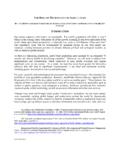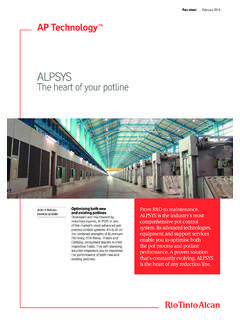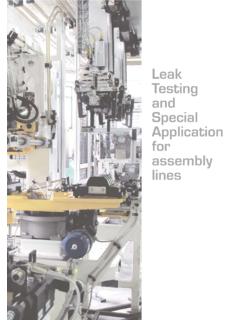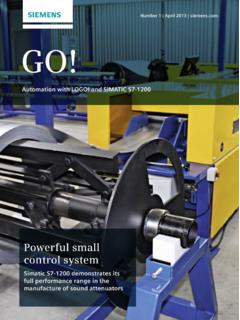Transcription of DECT Home Networking – The Next Step in Home Automation
1 DSP Group home Automation Whitepaper 1 DECT home Networking The next step in home Automation DSP Group Inc. Effi Shiri, VP Network Technologies, CTO Office Dr. Assaf Shappir, VP Innovation, CTO Office Raz Kivelevich-Carmi, Senior Product Line Manager, Marketing Dr. Haim Kupershmidt, Director, Communication Technologies, CTO Office Jochen Kilian, VP Core Technology Introduction Traditionally, DECT-based products have been limited to cordless phones packaged with PSTN-connected base units and IP-connected home gateways (HGWs) providing voice services. DECT technology, however, is ideally suited to support a broad array of applications. In fact, DECT audio/video baby and home monitors have been introduced in recent years, while the technology is deployed in a wide variety of products ranging from wireless microphones to home care pendants. DECT is also evolving as a residential wireless Networking technology for home Automation (HA).
2 Designed to provide greater convenience, comfort, energy efficiency, and security to consumers, home Automation systems include myriad applications such as lighting control; heating, ventilation and air conditioning (HVAC) control; and security ( intrusion alarm devices, smoke/gas leak detectors). Other home Automation applications on the rise include plant watering, pet feeding and pool pumps. Nearly any home device can be automatically or remotely monitored and controlled, making the potential for new home Automation product development virtually unlimited. The home Automation market is expected to grow significantly in the near future and total hundreds of millions of units, according to multiple research studies ( [1], [2], [3]). Figure 1 illustrates this market take-off, which is predicted to reach 38 million units in 2013.
3 The general consensus is that the home Automation market is close to an inflection point, beyond which it will grow even faster. DSP Group home Automation Whitepaper 2 Appliances HAN Chips (M) a rsHAN Chips (M)A-HAN Chips (M) Figure 1: Digital chipset growth WW (forecast); Source: DSP Group internal analysis In this paper, we show why DECT is an excellent technology for meeting home Automation market challenges. In addition, we explain how DECT is well positioned to address this market from a technological, economic and market perspective. home Automation Applications home Automation applications cover myriad areas including: Lighting Control Systems o presence-based automated on/off light switching ( motion/volume sensors) o light dimming according to ambient light level Smart Energy/Smart Grid Management o home smart appliance/smart switch control o heating, ventilation and air conditioning (HVAC) control Security Systems o intrusion detection: movement detection, glass breaking, magnetic door/window contact, other sensors o safety: smoke detectors, gas/water leak detectors o medical alert and tele-assistance services for elderly and disabled individuals Intercom: multi-room communications, automatic door camera viewing Other Applications.
4 Automated garage door, pet feeding and watering, plant watering, pool pumps and heaters, sump pumps DSP Group home Automation Whitepaper 3 home Automation Architecture home Automation typically includes the following architectural elements: home Gateway: The HGW connects the home premises to the PSTN/IP network, enabling the user or operator to remotely monitor and control equipment via the Internet or a PSTN network for simple use cases. home Area Network: The network enables access to home equipment being monitored. In- home Monitoring Devices: These devices enable local monitoring and control of home equipment ( mobile/mounted pad, multimedia phone handset, control unit). home Equipment: This equipment ( security sensors, smart appliances) is being monitored and controlled.
5 Remote Monitoring and Control: This involves remote equipment monitoring by residents ( air conditioning units), or remote service monitoring by service providers ( intrusion sensor monitoring by security companies, smart-grid control provisioning by utility service providers). Figure 2 illustrates DECT-based home Automation network architecture. Given that major telecom service providers are increasingly integrating DECT into home gateway equipment, HGW hardware is ready for such architecture even today. Figure 2: DECT-based home Automation architecture Carrier NWK IP/PSTNA ccess anywhere @ home Easy monitoring and control IPD / PAD / Tablet Remote Monitoring / Services Base Station / home Gateway with DECT DECT Telephony DECT/ Wi-FiEntertain- ment (Remote) Video Intercom Medicare Switch Control / White Appliances home Security DECT home Network Smart Energy / Metering DSP Group home Automation Whitepaper 4 home Automation Driving Forces In addition to the rising demand for enhanced convenience and comfort for end users, several other forces are driving home Automation technology forward.
6 Here are a few of these drivers. Regulatory and Insurance Implications Security systems featuring monitored smoke detectors and fire alarms hasten the response time of emergency services. Since faster response time saves lives and lowers the amount of damaged property, insurance companies are offering discounts of up to 20% to customers who install such systems ( [8], [9]). Beyond the requirements of insurance firms, monitored fire alarm systems are becoming mandatory in public places such as "clubs, theaters, auditoriums, conference venues and other places of assembly" ( [10], [11]). Imposition of these regulations by governments and insurance companies is further driving home Automation for safety and security applications. Insurance companies also offer generous discounts for installing intrusion sensors against burglary and home invasion ( [12], [13]).
7 The introduction of these alarm systems can be carried out via a basic DECT base station connected to a PSTN network. When a fire alarm, smoke detector or intrusion alarm is triggered, it automatically calls either a fire emergency service/security company (whereby the caller's location is retrievable via Caller ID) or the property owner, who can then call emergency services. Remote Healthcare and Tele-Assistance With the rise in life expectancy among modern societies driving health care costs to unprecedented heights, reducing the cost of caring for elderly and disabled individuals is becoming increasingly important. HA services such as remote health monitoring ( blood pressure, sugar level, regular drug intake) and tele-assistance ( emergency call support, drug reminders) can lower these costs.
8 Therefore, medical insurance companies and service providers are expected to push for further home Automation for these applications. For many of these use cases, connecting a DECT base to a PSTN network is sufficient. In fact, DECT-based personal emergency response systems are now quite popular ( [14], [15]). More sophisticated systems for monitoring ECG, blood pressure, drug intake, and other health-related areas are either available ( [16], [17]) or in advanced development stages ( [18]). Broadband Internet and Triple-Play Service Providers New Revenue-Generation Opportunity With the proliferation of broadband Internet services, broadband average revenue per user (ARPU) has been steadily declining, while overall growth of these services has slowed down ( [6]). ARPU has fallen by 30% from an DSP Group home Automation Whitepaper 5 annual average of $ in 2004 to $ in 2010.
9 During that same period, the annual growth rate of broadband services has decreased from 150% to 30%. While 30% still represents robust growth, the market is becoming increasingly competitive: over 80% of all broadband service in 2004 was supplied by phone operators via ADSL; in 2010, their market share fell to under 40%. Cable operators' broadband market share has also plummeted nearly in half, from 13% to 7%. Part of that share has been grabbed by wireless service providers including cellular operators that primarily provide 3G services and fiber-to-the- home (FTTH) operators ( [7]). Given these market developments, broadband operators are looking for new ways to provide value-added services (VAS) in order to keep customer attrition down and ARPU up. As a result, they view home Automation services including security, medical alert and tele-assistance services as an integral part of their offering.
10 Smart Grid and Green Energy Electrical power efficiency is one of the major challenges of the current era. And with emerging markets further increasing their demand for oil and gas, the cost of most energy sources is expected to rise, thereby making operational efficiency of existing facilities even more critical. Given these developments, smart grid management, including the utilization of tools for peak curtailment and leveling as well as time-of-use pricing, is becoming increasingly important. A recent study conducted by the US Department of Energy calculated that internal modernization of US grids with smart-grid capabilities would save between $46 billion and $117 billion over the next 20 years ( [4], [5]). For smart grids to implement advanced features such as load adjustment and demand response support ( automatic equipment shutdown for reducing power demand spikes and preempting power shortage failure), they require home Automation capabilities.










